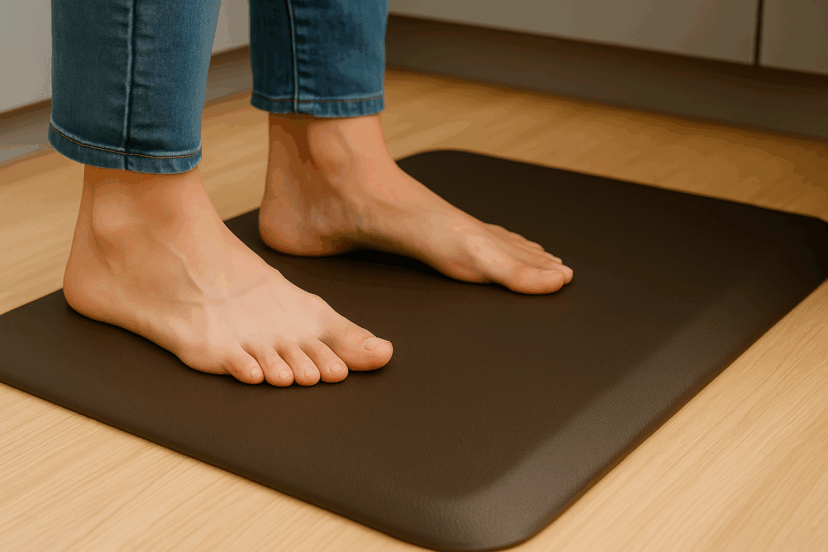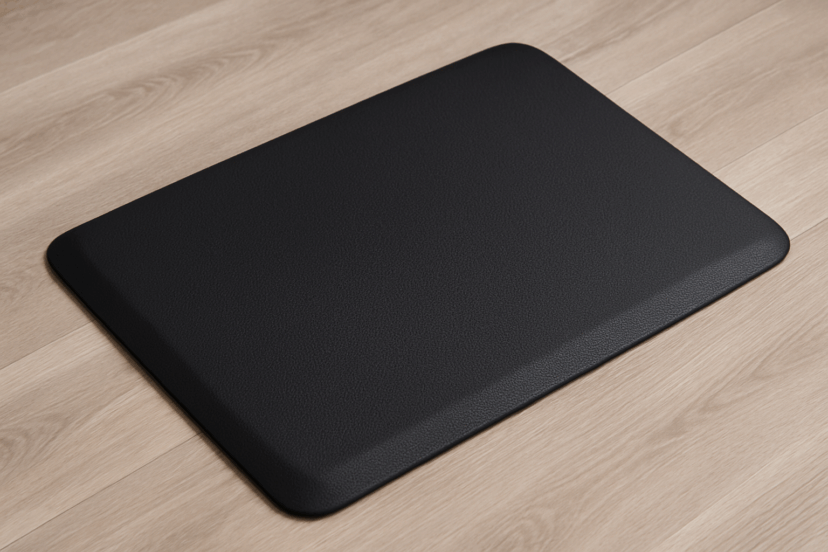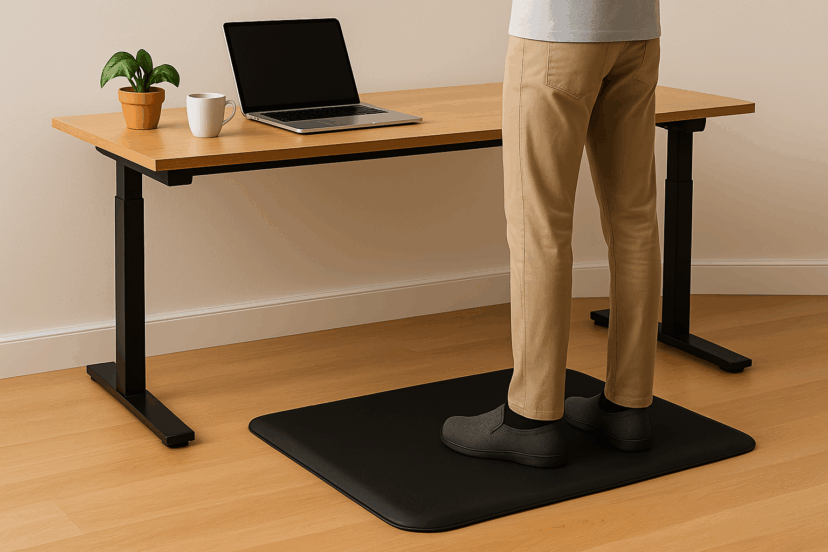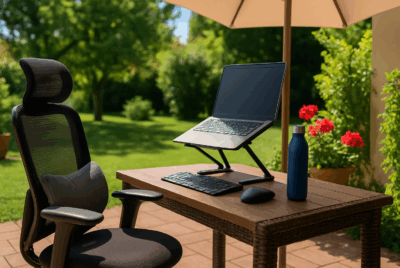Ergonomic Floor Mats: Best Picks for Comfort & Support
We may earn a commission for purchases made using our links. Please see our disclosure to learn more.
Standing for hours on hard floors can leave you tired, achy, and frustrated — it’s a problem many people just accept. But that daily strain on your feet, back, and legs can add up fast, making you feel worse over time. Luckily, good ergonomic floor mats can fix this by giving you soft, steady support where you need it most. In this guide, you’ll learn why these mats matter, what to look for, and how to choose the best one so you can stand comfortably and stay pain-free.
Why Ergonomic Floor Mats Matter
It might seem minor, but the surface you stand on has a major effect on how your body feels. Hard floors, such as tile, concrete, or hardwood, are demanding on your joints. They have no give, so your body absorbs all of the impact from standing, primarily in your heels, knees, and back.
Over time, the persistent pressure can cause weariness, lower back pain, and even circulatory problems. That is precisely why ergonomic floor mats exist: they are intended to comfort your feet while also encouraging tiny muscle movements that maintain blood flow.
Backed by credible studies, these mats really do make a difference. For example, a biomechanical study on standing mats found they reduce fatigue, improve balance, and lower peak pressure on your feet during long hours of standing. Similarly, another study on anti-fatigue mats for surgical teams showed significant drops in pain and tiredness among surgeons and nurses who used mats during operations.
The small, endless adjustments your muscles make when standing on a cushioned mat help distribute weight properly and relieve pressure on your lower back and knees, keeping you more comfortable and productive throughout the day.

Top 5 Ergonomic Floor Mats You’ll Love
Let’s explore some of the top ergonomic floor mats now available online. You can choose the one that best suits your space and price range because each one strikes a balance between comfort, durability, and cost.
1. Sky Solutions Anti-Fatigue Mat
There’s solid reason why the Sky Solutions mat is so popular. Its interior is made of soft foam that cushions your feet without making them feel overly soft. The surface is easy to clean and resistant to stains, making it perfect for use in the kitchen.
A lot of people also adore the chic appearance. It comes in a variety of colors and sizes, so comfort doesn’t have to be sacrificed for style. With a non-slip bottom and beveled sides to save people from tripping, it’s a sensible option for any house or workplace.
2. FEZIBO Standing Desk Mat
This one was designed with the home office crowd in mind. The FEZIBO Standing Desk Mat has a special contoured form that allows you to stretch, change your stance, and keep your legs moving. It’s like a tiny playground for your feet, allowing you to stand for longer periods of time without tiredness.
If you fidget or prefer to be active while working, this mat is worth considering. It’s especially popular among remote workers who spend hours at their standing desks.
3. Gorilla Grip Premium Anti-Fatigue Mat
When durability is a top priority, Gorilla Grip has you covered. This mat is thicker than many budget options and holds up well to heavy daily use. The high-density foam core gives just enough cushion to reduce pressure on your joints while staying firm enough to maintain good posture.
It also has a non-slip backing and beveled edges, so it won’t curl up or slide around. The water-resistant surface wipes clean easily—perfect for messy tasks like food prep or crafts.
4. ComfiLife Anti-Fatigue Floor Mat
If you’re looking for a mat that balances plush comfort and strong support, the ComfiLife Anti-Fatigue Floor Mat consistently gets high marks. Users rave about how it feels underfoot—soft but supportive, with no sinking feeling.
It comes in a range of sizes, so you can fit it in front of your sink, stove, or workbench. Plus, it’s built with stain-resistant material that’s easy to wipe down with just a damp cloth.
5. Amazon Basics Anti-Fatigue Standing Mat
Don’t let the simple design fool you. The Amazon Basics Anti-Fatigue Mat is proof that you don’t have to spend a fortune for better comfort. This mat gets the job done, offering reliable cushioning and a non-slip bottom to keep you steady.
It’s lightweight, easy to move around, and fits well in tight spots like laundry rooms or small kitchens. If you’re new to using ergonomic mats, this is an affordable entry point to see how much difference a little padding can make.

What to Look for When Buying Ergonomic Floor Mats
Not all floor mats are created equal. The wrong one could wear out fast, slip around dangerously, or flatten like a pancake after a few weeks. Here’s what to watch for when shopping:
Material & Thickness
The core of any good ergonomic mat is its material. High-density foam, gel-infused foam, or a combination of both provides the best blend of support and durability. A mat that’s too soft may feel comfy at first but can lose shape quickly.
Aim for a mat that’s at least ¾ inch thick. This sweet spot offers enough cushion to reduce fatigue without making you feel off-balance.
Size & Shape
Measure your space before buying. Small mats work well in front of sinks or stoves, while larger mats are better for workstations or laundry areas. If you’re using a standing desk, look for mats with contoured edges or textured surfaces that encourage movement.
Non-Slip Backing
Safety first. A quality anti-fatigue mat should stay put on your floor type—whether it’s hardwood, tile, or concrete. Non-slip backing and beveled edges reduce the risk of tripping.
Easy Cleaning
Spills happen. Choose mats with stain-resistant or waterproof covers. Some wipe clean with just soap and water, saving you hassle in busy areas like kitchens.
Warranty & Customer Reviews
A reliable brand often backs their mats with a warranty. Take time to read reviews, too. Real user experiences can reveal if a mat holds up over months of daily use.
Tips for Getting the Most Out of Your Mat
A good mat helps, but your standing habits matter too. Here are a few quick tips:
- Alternate your stance. Shift your weight, move your feet, or try stepping side to side every so often.
- Wear supportive shoes. A mat alone won’t fix poor footwear.
- Take breaks. Sit, stretch, or walk around regularly.
- Keep your posture in check. Stand tall with your shoulders relaxed and your knees soft—not locked.
Combining a quality mat with healthy habits keeps you feeling your best.
Final Thoughts
A good ergonomic floor mat is one of the simplest ways to stay comfortable when you spend hours on your feet. Backed by research, these mats help reduce fatigue, ease pressure on your joints, and improve your posture over time. Instead of walking away with sore feet and an aching back, you’ll feel better and stand longer without discomfort.
If you’re ready to stand smarter, pick a mat that fits your space — and don’t forget to check out our camping essentials for comfort and support to stay pain-free wherever life takes you.
FAQs
1. What makes a floor mat ergonomic?
It’s all about how the mat cushions your feet and encourages tiny movements to reduce fatigue. Good mats use high-density foam or gel that balances softness and firmness.
2. Can floor mats help with back pain?
Yes! By supporting proper posture and easing pressure on your spine and joints, ergonomic mats can help reduce or prevent lower back pain.
3. How do you clean an ergonomic mat?
Most mats wipe clean with a damp cloth and mild soap. Always check your mat’s care instructions to avoid damage.
4. Where should I use my mat?
Anywhere you stand for extended periods—like kitchens, laundry rooms, workshops, or at a standing desk. Some people even keep one in their garage or craft room.
5. Can you use them on all kinds of flooring?
Generally, yes. Look for mats with non-slip backings that work well on tile, wood, or concrete. Be sure the edges lay flat to prevent tripping.




